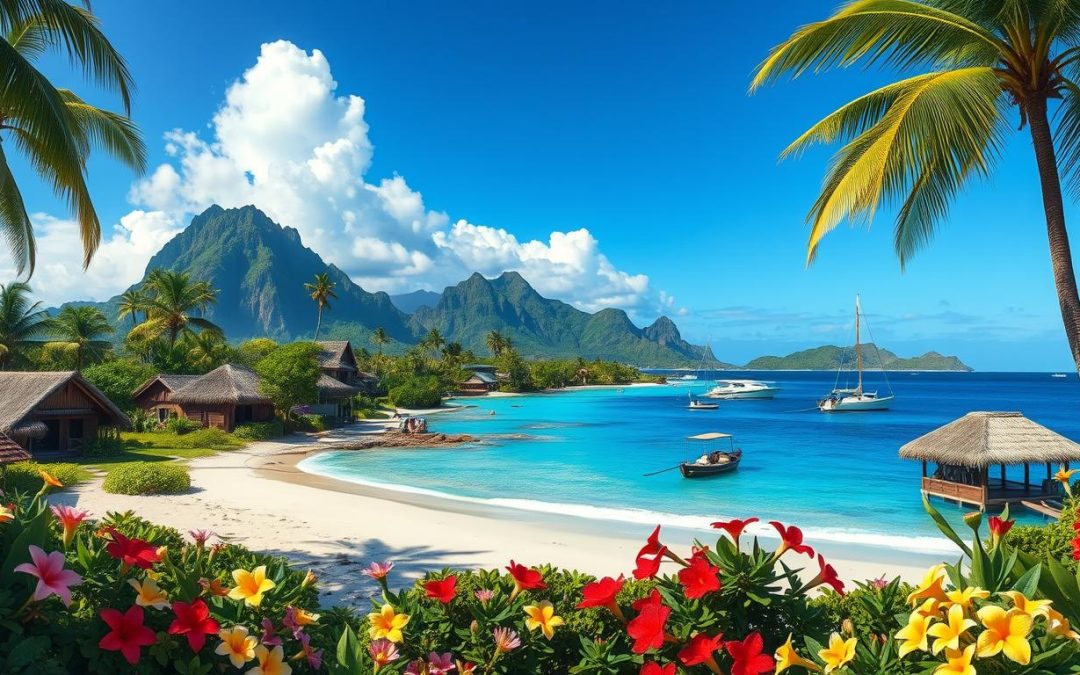Have you ever wondered how a tiny Pacific paradise manages to balance multiple languages while preserving its unique cultural identity?
French Polynesia presents a fascinating linguistic tapestry that goes beyond simple communication. With French as the official language and Tahitian deeply rooted in cultural heritage, this archipelago represents a remarkable blend of linguistic diversity.
Since 1996, French has been the sole official language of French Polynesia, establishing a clear administrative framework. Yet, the linguistic landscape is far more nuanced than a single tongue might suggest. Nearly 95.2% of residents can speak, read, and write French, while simultaneously maintaining strong connections to their indigenous languages.
The 2017 census revealed an intricate language distribution: 73.9% speak French, 20.2% speak Tahitian, and other regional languages like Marquesan and Tuamotuan continue to play crucial roles in community communication.
Key Takeaways
- French is the official language of French Polynesia
- 95.2% of residents are fluent in French
- Tahitian remains a significant cultural language
- Multiple indigenous languages coexist
- Language reflects the rich cultural diversity of the islands
Understanding Language Distribution in French Polynesia
French Polynesia, as an Overseas collectivity of France, has a rich language scene. It shows the area’s cultural history. The mix of Indigenous languages and historical influences is a story of keeping culture alive and changing.
The languages in French Polynesia come from Austronesian languages. These have shaped talks across the islands for ages. Let’s look at how language spreads out in this area.
Current Language Demographics
The 2017 census shows a mix among people aged 15 and older:
- French: 73.9%
- Tahitian: 20.2%
- Marquesan: 2.6%
- Austral languages: 1.2%
- Tuamotuan: 1.0%
Geographic Language Distribution
Language changes from island to island. Each place has its own language traits. This shows the complex cultural mix that has shaped French Polynesia over time.
Historical Language Evolution
The language history of French Polynesia shows its cultural changes. From ancient Polynesian travels to French rule, languages have evolved.
“Languages are the roadmaps of a culture. They tell you where its people come from and where they are going.” – Rita Mae Brown
Knowing this language journey helps us value French Polynesia’s cultural heritage. It also shows the efforts to keep its unique languages alive.
French as the Official Language
French is key in French Polynesia, being an overseas collectivity of France. It’s the main way people talk in government, schools, and media. This language is everywhere in the islands.
Let’s dive into the world of French in this Pacific area:
- 95.2% of residents aged 15 or older can speak, read, and write French
- Only 1.3% report having no knowledge of French
- French is the official administrative language
“Language is the road map of a culture. It tells you where its people come from and where they are going.” – Rita Mae Brown
The use of French shows the strong bond between French Polynesia and France. Even though they are far apart, they share a deep language connection.
| Language Metric | Percentage |
|---|---|
| French Speakers (15+ years) | 95.2% |
| No French Knowledge | 1.3% |
| Total Population | 284,060 |
French is a big part of everyday life here. You’ll see it in official papers, TV shows, schools, and government work. It brings the islands together as a overseas collectivity of France.
Tahitian Language and Its Cultural Significance
The Reo Tahiti is a key part of French Polynesian culture. It connects people across generations and keeps the spirit of indigenous communities alive.
Tahitian is more than words. It shows the strength of indigenous languages. About 68,260 people speak it, making up 37% of French Polynesia’s ethnic population.
Unique Vocabulary Structure
The Tahitian language has a special way of speaking:
- Five distinctive vowels
- Nine consonants
- Approximately 1,000 core vocabulary words
- Entirely open syllable structure
Modern Usage and Preservation
There’s a big push to keep Reo Tahiti alive. Since 1981, it’s been taught in schools. This keeps the language vibrant.
“Language is the roadmap of a culture. It tells you where its people come from and where they are going.” – Rita Mae Brown
Cultural Impact on Daily Life
Tahitian is everywhere in island life. It’s used in ceremonies and modern art. Words like “tatau” (tattoo) show deep connections to the past.
- Used in traditional music with instruments like pahu and vivo
- Integral to culinary practices
- Essential in storytelling and artistic expressions
- Connects individuals to their indigenous heritage
Learning Tahitian is more than just speaking. It’s joining a living cultural legacy in French Polynesia’s beautiful islands.
The Role of Indigenous Languages
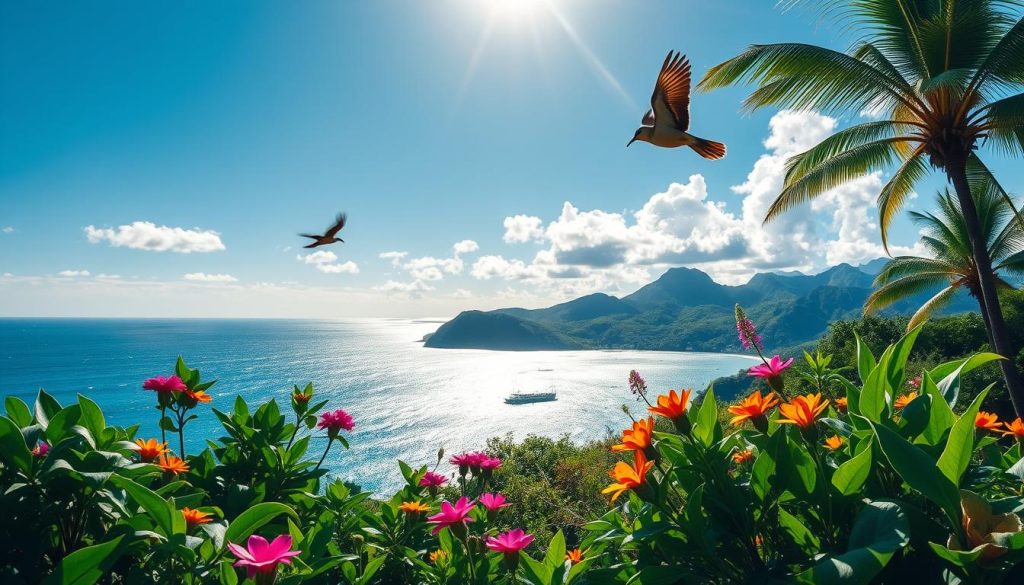
French Polynesia is home to a rich mix of languages. These languages are key to the culture of the Pacific islands. They connect communities through a shared heritage.
Indigenous languages in French Polynesia are more than just Tahitian. They include many different ways of communicating. This shows the area’s complex cultural identity. About 86.5% of people aged 15 or older know at least one Polynesian language.
“Language is the roadmap of a culture. It tells you where its people come from and where they are going.” – Rita Mae Brown
- Marquesan languages represent unique indigenous communication systems
- Tuamotuan languages preserve ancient communication patterns
- Austronesian languages connect island communities
- Indigenous languages maintain cultural memory and traditions
These languages do more than just help people talk. They hold cultural knowledge, stories, and traditions. They define what it means to be Polynesian.
| Language Group | Primary Islands | Speakers |
|---|---|---|
| Tahitian | Society Islands | 78,000 |
| Marquesan | Marquesas Islands | 8,500 |
| Tuamotuan | Tuamotu Archipelago | 12,000 |
Learning about French Polynesia’s languages shows how important they are. They are not just ways to talk. They are bridges to the past and present.
French Polynesia: Official and widely spoken languages
Exploring French Polynesia’s languages shows a mix of history and culture. The language scene here is shaped by both official rules and cultural traditions.
Statistical Language Overview
French Polynesia is home to many languages living together. Official numbers give us a peek into how people communicate:
- French is spoken by 100% of the population
- Tahitian is spoken by about 30% of residents
- Other regional languages include Austral, Raivavae, Rapa, and Tuamotuan
Language Policy Framework
A key law from 12 April 1996 sets the language rules in French Polynesia. It makes French the official language. At the same time, it values Tahitian and other Polynesian languages for communication.
“French is the official language, Tahitian and other Polynesian languages can be used.” – Organic Law, 1996
Linguistic Diversity and Regulations
The language policy aims to keep cultural heritage alive while ensuring smooth administration. Efforts to save Tahitian language are strong. Schools and community programs work hard to keep it alive.
Knowing about these language rules helps us see the rich cultural mix of French Polynesia. Here, many languages work together to make the region’s culture even richer.
Marquesan and Tuamotuan Languages
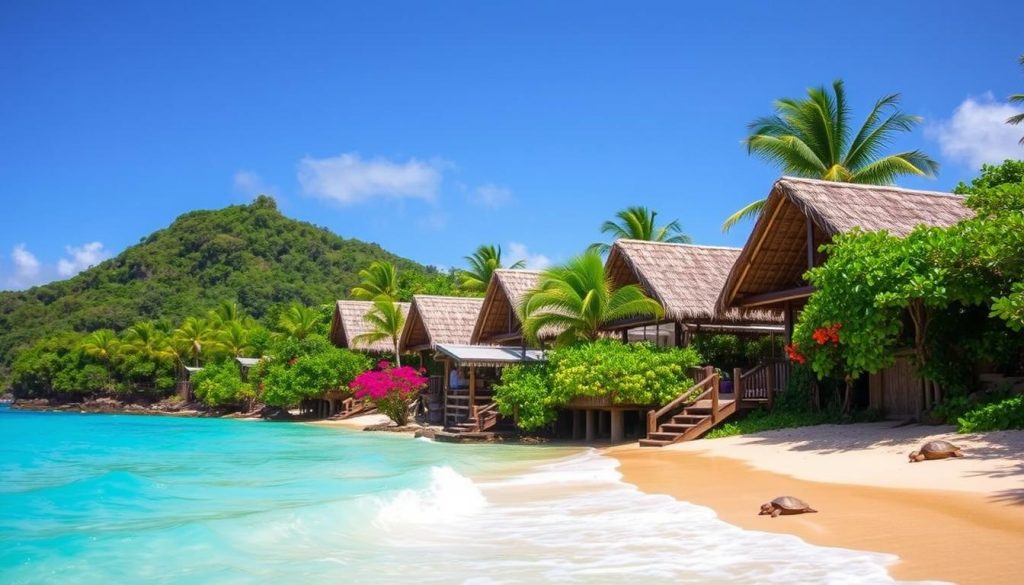
French Polynesia is home to a rich mix of languages. Indigenous languages like Marquesan and Tuamotuan are key to keeping culture alive. They show the deep roots of the region’s people.
The Marquesan language has many dialects, mainly in the Marquesas Islands. About 2.6% of people aged 15 and up speak Marquesan. This language is still widely used in its native area.
“Language is the roadmap of a culture. It tells you where its people come from and where they are going.” – Rita Mae Brown
Tuamotuan languages are spoken by around 1.0% of people, mostly in the Tuamotu Archipelago. It stands out for its unique traits, unlike other Polynesian languages.
- Marquesan language originates from the Marquesas Islands
- Tuamotuan is primarily spoken in the Tuamotu Archipelago
- Both languages are considered indigenous languages of French Polynesia
Researchers have found many interesting things about these languages:
| Language | Speakers | Geographic Region |
|---|---|---|
| Marquesan | 2.6% | Marquesas Islands |
| Tuamotuan | 1.0% | Tuamotu Archipelago |
Efforts are being made to save these languages. This way, future generations can keep in touch with their cultural roots through language.
Language Education System in French Polynesia
French Polynesia’s education system is special. It mixes French, Tahitian, and English. This approach keeps cultural heritage alive while getting students ready for the world.
School Language Programs
Children in French Polynesia start learning at age 5. They learn many languages:
- French is the main language taught
- Tahitian is for cultural learning
- English is introduced in elementary school
Education is required from ages 6 to 16. Schools are free, thanks to the government. In Tahiti, 98 percent of people can read, showing the success of this education.
Language Teaching Methods
New teaching methods help with learning many languages:
- Integrated language learning programs
- Cultural context-based language instruction
- Specialized language preservation initiatives
“Language is the roadmap of a culture. It tells you where its people come from and where they are going.” – Rita Mae Brown
The University of French Polynesia is key for advanced language studies. It has about 2,898 students as of 2019. Students can study languages while keeping ties to their culture.
Despite challenges, like limited resources in some islands, the effort to teach languages is strong. In outer islands, only 20 percent of kids finish elementary school. But the dedication to language education in French Polynesia is unwavering.
English Language Influence in Tourism
In French Polynesia, tourism has become a big driver for English learning. Visitors from all over make English a key language for talking. Local workers see learning English as a way to get ahead in tourism and hospitality.
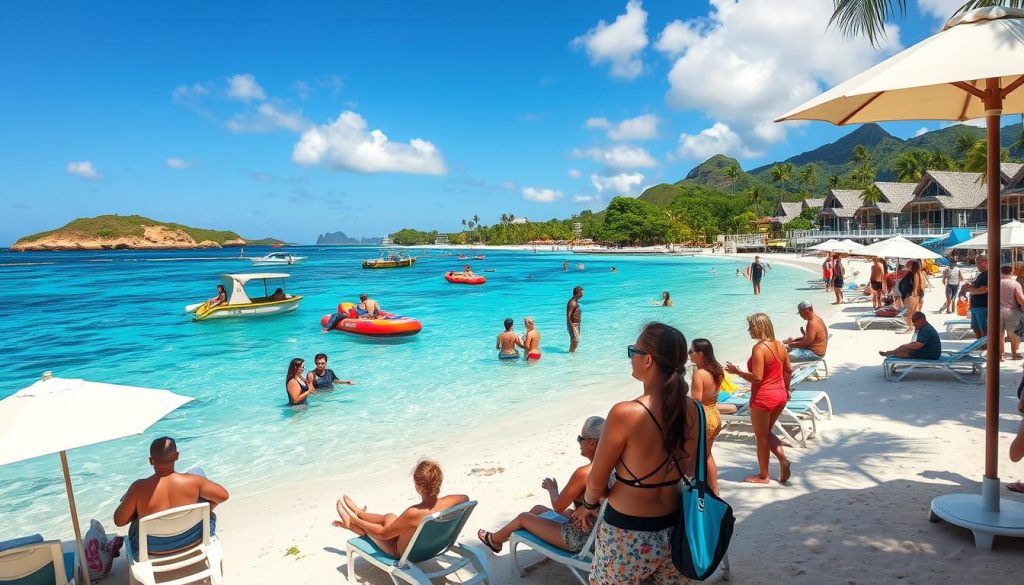
The need for English in tourism has really grown. Employers want people who can talk well with guests from other countries. This shows how tourism has become a global thing, needing people who speak many languages.
- 80% of tourism workers talk to English-speaking tourists often
- Hotels and resorts need people who can speak some English
- More language classes are being offered to meet tourism needs
“English has become the global language of tourism, connecting cultures and creating opportunities.” – Tourism Language Expert
Now, knowing English is key for moving up in tourism in French Polynesia. Schools are teaching English for the tourism industry. This helps young people get jobs in the global market.
| Language Skill Level | Percentage of Tourism Workers |
|---|---|
| Basic English | 45% |
| Intermediate English | 35% |
| Advanced English | 20% |
Using English in tourism in French Polynesia shows a smart way to talk to the world. As tourism keeps changing, knowing languages will keep being important for great visitor experiences.
Language Preservation Efforts
French Polynesia is at a crucial point in saving its rich language heritage. The fight to keep indigenous languages like Tahitian and other Reo Ma’ohi alive is urgent. Both the government and community groups are deeply concerned.
Government Initiatives for Indigenous Languages
The French Polynesian government has launched important programs to protect local languages. These efforts cover several key areas:
- Developing detailed language documentation programs
- Offering funds for linguistic research
- Creating school curriculum resources for Reo Tahiti
- Supporting digital archives of indigenous language materials
Community-Driven Preservation Strategies
Local communities are key in keeping indigenous languages alive. Their efforts include:
- Setting up language nests for young learners
- Hosting cultural festivals to celebrate linguistic diversity
- Creating media content in local languages
- Starting programs to pass languages down through generations
“Our language is our soul, our identity,” says a local Tahitian language activist.
Through government support and community enthusiasm, French Polynesia is working hard. They aim to keep indigenous languages alive and thriving for generations to come.
Impact of Globalization on Local Languages
Globalization is changing French Polynesia’s language scene a lot. Digital tech and global talks are making it tough for local tongues. Keeping cultural identity alive while joining the world is a big worry for locals.
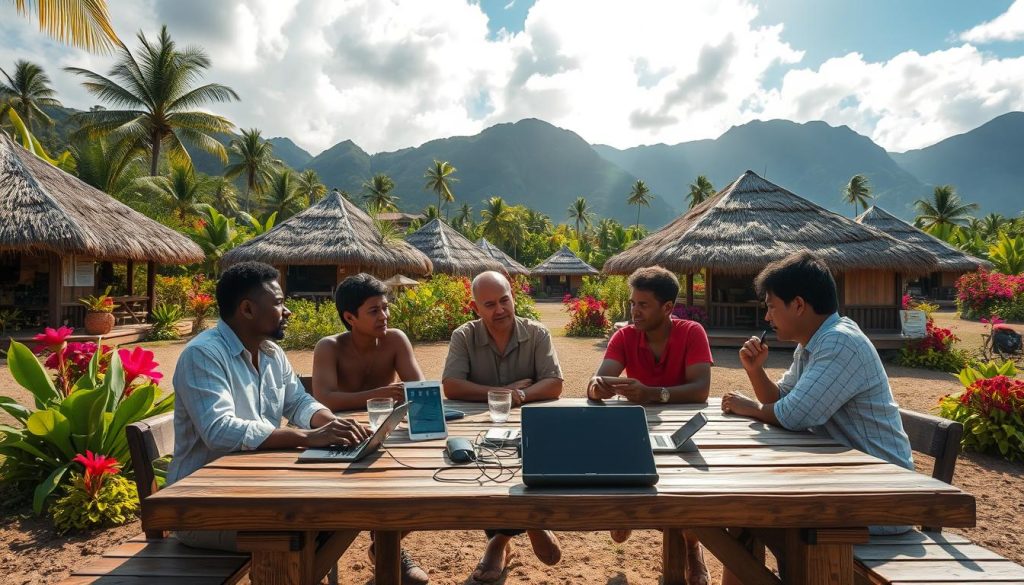
- Digital media is speeding up language changes
- Young folks are choosing French and digital talk more
- Money issues are pushing for global languages
“Language is the roadmap of a culture. Tell me the language, and I’ll tell you who the people are.” – Carlos Fuentes
Here are some stats that show big changes:
| Language Indicator | Current Status |
|---|---|
| Indigenous Language Speakers | Declining 30% over three decades |
| Bilingual Population | 85% speak French and local languages |
| Urban Youth Language Preference | 30% speak exclusively French |
A UNESCO report says about 48% of people think globalization is a threat to their languages and cultures. French Polynesia is at a turning point. Tech is making it hard to keep traditional language ways alive.
Now, efforts to save languages are becoming key. Local governments and groups are working to protect native tongues. They see these languages as key to their culture and who they are.
Modern Communication and Language Adaptation
Digital technologies are changing how languages work in French Polynesia. They offer new ways for French, Tahitian, and English to mix and grow. The digital world is full of creativity and cultural expression.
Digital Language Platforms
Social media and messaging apps are key for language use. Young people in French Polynesia mix Tahitian, French, and English online. They create their own digital language ways.
- Text messaging enables rapid language mixing
- Social media platforms facilitate multilingual conversations
- Online forums showcase linguistic diversity
Social Media Language Trends
Digital platforms help keep languages alive and fresh. Tahitian speakers use social media to stay connected and try new words.
Digital communication is reshaping how languages coexist and interact in French Polynesia.
| Language Platform | Primary Usage | User Engagement |
|---|---|---|
| Multilingual interactions | High | |
| Visual storytelling | Medium | |
| Code-switching communication | Very High |
The digital world is a lively place. French Polynesian languages are adapting, interacting, and growing in new ways.
Conclusion
Exploring French Polynesia’s language scene reveals a rich mix of tongues. This Pacific paradise is home to 300,000 people across 118 islands. Here, French and indigenous languages blend and interact in a unique way.
The balance between keeping languages alive and adapting to change is key here. French is the main language for 92% of the population. Yet, Tahitian and other native tongues are vital for cultural identity. About 65% of people use both French and Tahitian every day, showing the area’s deep multilingual roots.
French Polynesia’s language story shows a community dedicated to keeping languages diverse. Despite global influences, locals are working hard to save their native tongues. About 60% of Tahitians want to keep their language alive, showing the area’s cultural strength.
Looking ahead, French Polynesia is a beacon for language preservation and adaptation. This journey highlights the importance of language in keeping culture alive while connecting with the world. The future of communication here is as varied and lively as its people.
The above is subject to change.
Check back often to TRAVEL.COM for the latest travel tips and deals.
Here are some Tours & Sightseeing suggestions that might pique your interests!
